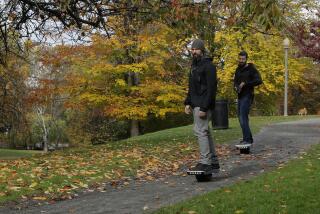THE GOODS : Low Ratings for Child Seats Cause a Furor for Magazine
The editors of Consumer Reports are accustomed to protests from angry manufacturers and queries from conscientious buyers, but nothing like the flood they faced after recently branding three popular child safety seats possibly dangerous.
The magazine scooped itself two weeks ago by holding a news conference to announce what it called catastrophic failures in three of 25 seats it tested, including one of the nation’s top-selling infant seats, the Century model 590.
The findings will be published in the September issue, which will be mailed to subscribers today and hit newsstands Aug. 22.
In the days following the announcement, the magazine received nearly 2,800 calls a day, a representative said.
Those calls reflected a fraction of the panicked consumers whose calls flooded car seat manufacturers, child safety advocacy groups and government agencies.
Ricardo Martinez, head of the National Highway Traffic Safety Administration, issued a statement Monday saying his agency had fielded more than 55,000 calls. He said the agency had not heard of any of the three seats failing in real-life crashes, as they did in the magazine’s tests.
“Parents across the country are understandably confused and concerned that the safety seat they are using may not be safe,” Martinez said.
“I want to set the record straight: Parents should have confidence in any safety seat that meets the federal safety standard.”
(Evenflo announced a recall on a government-approved seat June 29, though it was unknown to many product owners and Consumer Reports until shortly before the news conference.)
Many child safety advocates said more testing was needed, but few believed the seats should be immediately recalled.
Century Products Co., the nation’s largest manufacturer of child safety seats, questioned the Consumer Reports testing--even though the magazine’s tests were conducted by the same laboratory used by Century.
Consumer Reports declined to name the lab, citing a secrecy agreement.
The company said the results were “completely contrary to all testing conducted by Century in at least four independent laboratories over the four-year period during which the model 590 car seat has been manufactured.”
The day after the news conference, Century said it had conducted a dozen new tests identical to the ones conducted by Consumer Reports and did not find one seat that failed.
But R. David Pittle, vice president and technical director of Consumers Union, publisher of Consumer Reports, said the magazine was confident enough to ask the manufacturers to recall their seats and petition the government to strengthen its certification standards.
“If the government compliance tests and the government testing were adequate, those problems should not have been in the marketplace,” Pittle said.
The magazine also found what appeared to be potentially deadly design flaws in the Kolcraft Traveler 700 convertible seat and the voluntarily recalled Evenflo On My Way model 206 infant seat.
(Kolcraft said it would investigate why its seat failed the tests but noted that it has passed more than 100 tests by independent laboratories.)
*
The magazine tested 25 models representing seven brands of child seats in a simulation of a 30 m.p.h. head-on crash.
Models included infant seats for babies up to 20 pounds (about the weight of a 9-month-old); convertible seats that can be used facing the rear for infants and facing the front for children ages 1 to 4, and booster seats for children 3 to 6.
Consumer Reports testers made their tests slightly tougher than federal standards require to see whether they could safely carry the heaviest weights for which they were certified.
Instead of using the government standard 17 1/2-pound dummy for infant seats, for example, the magazine used a 20-pound dummy.
The Century 590 model failed four consecutive tests when the detachable base was used; the carrier broke free at the moment of impact.
The same seat used without the base, known as the Century 565, performed well and is rated a Best Buy in the September issue.
In contrast to the Century 590, the Evenflo seat slipped loose when used without the base, and performed acceptably when used with its base.
Evenflo said that the flaw was limited to models produced before May 31, 1995, and that no injuries have been reported.
The Kolcraft Traveler 700 provided the most dramatic failure: a series of four photographs accompanying the article show a dummy being thrown from the seat after the seat’s buckle failed.
More to Read
Inside the business of entertainment
The Wide Shot brings you news, analysis and insights on everything from streaming wars to production — and what it all means for the future.
You may occasionally receive promotional content from the Los Angeles Times.










